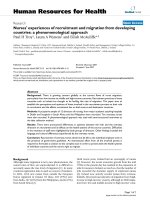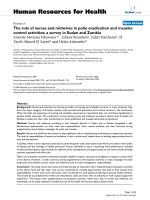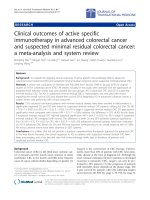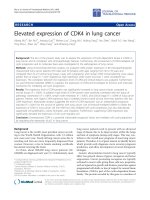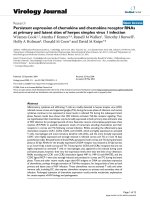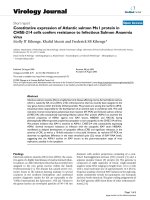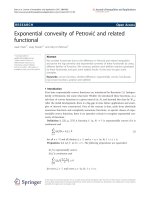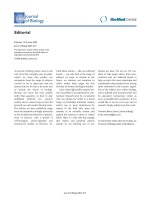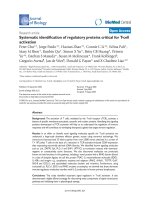Báo cáo sinh học: " Infectious causes of cancer and their detection" doc
Bạn đang xem bản rút gọn của tài liệu. Xem và tải ngay bản đầy đủ của tài liệu tại đây (138.05 KB, 5 trang )
Dalton-Griffin and Kellam: Journal of Biology 2009, 8:67
Abstract
Molecular techniques for identifying pathogens associated with
cancer continue to be developed, including one reported
recently in BMC Medical Genomics. Identifying a causal infec-
tious agent helps in understanding the biology of these cancers
and can lead ultimately to the development of antimicrobial
drugs and vaccines for their treatment and prevention.
In 1911, Peyton Rous used cell-free filtered extract of a
chicken sarcoma to establish an association between
cancer and an infectious agent - the Rous sarcoma virus.
Almost 100 years later, developments in the techniques
used to detect microbial genomes and investigate their
biological properties have led to a definitive role for viral,
bacterial and parasitic infection in human carcinogenesis.
Recent estimates indicate that the average proportion of
malignancies worldwide that could be avoided in the
absence of an infectious agent is 17.8%, with this figure
being higher in developing countries, at 26.3% [1].
The development of cancer is a complex multistage process
that, as outlined by Hanahan and Weinberg [2], can be
grouped into “six essential alterations to the cell physio-
logy” (Figure 1). These changes most likely occur by a
progressive, almost evolutionary mechanism of successive
genetic changes. The main mechanisms by which chronic
infection promotes cancer do not usually involve direct
mutagenesis, but instead are due to the complex
interactions that occur between host and pathogen. In
order for viruses to replicate and persist, they often
promote cell survival, drive cellular proliferation, and
evade the immune system. Together, these processes,
especially if present over a long period of time, can lead to
tumorigenesis, often by influencing the same pathways
that are involved in the development of cancer in the
absence of infection (Figure 1).
Indeed, several of the key mediators of pathways and
networks proposed by Hanahan and Weinberg were
discovered through the study of viruses. Many oncogenes,
for example Ras and Myc, were identified originally in
cancer-causing retroviruses. Similarly, the study of DNA
virus proteins, such as SV40 large T-antigen, was instru-
mental in discovering tumor suppressor genes such as p53.
Understanding the biology of oncogenic infections will
most likely continue to inform cancer biology in general.
One challenge is that of identifying potentially oncogenic
agents and proving their causal connection with cancer. A
recent paper in BMC Medical Genomics by Duncan et al.
[3] describes the new computational technique of digital
karyotyping microbe identification (DK-MICROBE), and
its application to identifying pathogens. Their paper
further exemplifies both the potential of molecular and
bioinformatics methods for identifying pathogen DNA in
tumor samples, but underlines the necessity of establishing
a causal association rather than just a pathogen presence.
How infectious agents cause cancer
The major mechanisms by which infectious agents can
promote and maintain tumor formation can be divided
broadly into three main categories (Figure 2). The first is
the induction of chronic inflammation as a result of a
continuing immune response to a persistent infection. This
occurs, for example, in the case of hepatitis C virus (HCV),
associated with liver cancer, which continually replicates in
the liver, setting up a chronic state of inflammation there.
Similarly, the blood fluke Schistosoma haematobium and
the Gram-negative bacterium Helicobacter pylori can both
directly contribute to cancer formation through persistence
within the host causing chronic inflammation [4]. H. pylori
is a good example of this category, and was classified by the
World Health Organization as a class 1 carcinogen in 1994.
There is a high prevalence of persistent infection with
H. pylori: worldwide, 75% of people are infected, with
prevalence being higher in sub-Saharan Africa, where
H. pylori is associated with 63.4% of all stomach cancers
[1]. However, the fact that not all people infected with
H. pylori develop gastric cancer clearly shows that the
infectious agent is a risk factor, but that other
environmental and genetic influences are involved in
cancer formation.
Second, oncogenesis can occur through virus-induced
transformation. This is due to the persistence of the viral
genome in a latent form in an infected cell, either without
Minireview
Infectious causes of cancer and their detection
Lucy Dalton-Griffin* and Paul Kellam*
†
Addresses: *Department of Infection, University College London, Cleveland Street, London W1T 4JF, UK.
†
The Wellcome Trust Sanger
Institute, The Wellcome Trust Genome Campus, Hinxton, Cambridge CB10 1SA, UK.
Correspondence: Paul Kellam. Email:
67.2
Dalton-Griffin and Kellam: Journal of Biology 2009, 8:67
replication, as with Epstein-Barr virus (EBV), which
infects B lymphocytes, or through integration of the viral
genome into a host-cell chromosome, as with human
papilloma virus (HPV), the cause of cervical cancer. EBV is
frequently detected in childhood Burkitt’s lymphoma,
post-transplant B-cell lymphomas, non-Hodgkin’s
lymphoma, Hodgkin’s disease and nasopharyngeal
carcinoma [1]. The trans forming capability of this virus is
exemplified further by its ability to transform resting B
cells in vitro at high efficiency to obtain stable proliferating
lymphoblastoid cell lines. This process is driven by EBV-
encoded latent proteins that directly promote cell growth
and survival - for example, lymphocyte membrane-
associated protein-1 (LMP-1) .
The third mechanism is the chronic suppression of the
immune system by the infectious agent, such as the
immunodeficiency (AIDS) caused by HIV infection. The
presence of natural mechanisms of immunosurveillance
for cancer cells, which in the case of an infectious etiology
will also involve immune mechanisms that routinely
control the infection, suggests why pathogens with onco-
genic potential do not rapidly cause malignancy. A compro-
mised immune system can result in an increased incidence
of infection-driven tumors by weakening the immune
control. Such an increase is seen, for example, in transplant
patients, who are being treated with immunosuppressants,
or in individuals with AIDS [5].
Pathogens associated with cancer exemplify many of these
mechanisms; persistent infection involves evading the
immune response as well as chronic inflammation, which
even in the immune-competent leads to chronic cell
proliferation and a greater risk of oncogenic
transformation. However, many non-oncogenic pathogens
are equally adept at these processes, indicating that other
factors must be involved. For example, the risk of an
infectious agent causing cancer may also depend on the
cell type infected, as certain cell lineages could be more
‘prone’ to transformation than others. For example, the
increased prevalence of lympho mas and leukemias in
children and young adults suggests that lymphocytes are
more susceptible to transformation.
Detecting infectious agents in cancer
‘The harder you look the more you find’ seems to be true
for infectious agents in disease. The ability of some agents
to remain latent, as well as the existence of new and
emerging infections [6], make detection and proving
causality challenging. An infectious agent may trigger the
initial events of oncogenesis but be absent in the final
tumor, which adds timing of detection to the problem.
Figure 1
Continued persistent infection by a pathogen (outer circle) requires host-cell survival (red), host-cell proliferation (yellow), and evasion of the
immune system by the pathogen (blue). These pathogen-driven processes are achieved via various mechanisms that interfere with normal
cell physiology and are outlined in Figure 2. Alterations in these normally highly regulated pathways can lead to transforming events that
have been described as the ‘hallmarks of cancer’ (inner circle) [2]. Accumulation of such events can lead to cancer development. Cancer is
not, however, an outcome that has been specifically selected by evolution to aid pathogen survival. Rather, it is more likely an unfortunate
coincidence of pathogen capabilities selected to enable successful infection. Therefore, certain infections may not necessarily cause the
infected individual to develop cancer, but may be an associated risk factor (Figure adapted from [2]).
CANCER
The hallmarks
of cancer
Pathogen driven
Evading the
immune system
Cell survival
processes
Cellular proliferation
Evading
apoptosis
Self-sufficiency in
growth signals
Insensitivity to
anti-growth signals
Tissue invasion
and metastasis
Limitless
replicative potential
Sustained
angiogenesis
67.3
Dalton-Griffin and Kellam: Journal of Biology 2009, 8:67
However, once the causal agent has been unequivocally
found, development of a preventive treatment can be
relatively rapid, as has been the case for cervical cancer.
Human papilloma viruses, especially types HPV16 and
HPV18, are now firmly associated with cervical cancer after
their discovery in 1983, and this has led to the development
and widespread use of an HPV vaccine within 25 years - a
timescale not dissimilar to that of drug discovery.
Similarly, recovery of immune function in AIDS by inhibit-
ing HIV replication by antiretroviral therapy can lead to a
regression of Kaposi’s sarcoma, an endothelial tumor
caused by the herpesvirus KSHV, and a decrease in inci-
dence of other AIDS-related cancers.
Treating infection is therefore a valuable addition to
antitumor therapy if the infectious agent can be identified.
Today, two main techniques are used to detect microbial
genomes in disease, one based on hunting for acknow-
ledged candidates and the other on removing (either
physically or computationally) known human sequences to
reveal any foreign nucleic acid. PCR and microarray-based
strategies are limited by a finite number of probes and
sequences available but can be very sensitive. Subtractive
methods include representational difference analysis
(RDA), which was used to detect KSHV in Kaposi’s sar-
coma in 1994. They do, however, require isogenic controls,
which are not always readily available.
Figure 2
Infectious agents can contribute to malignant transformation by several mechanisms. These can be broadly divided into: chronic
inflammation, which drives abnormal levels of cell proliferation (yellow); direct virus-induced transformation of infected cells, leading to
increased cell survival (red); and immunosuppression, which allows the pathogen to evade the immune system and persist (blue). The colour
coding is maintained from Figure 1. Chronic inflammation leads to the production of inflammatory cytokines as well as reactive oxygen and
nitrogen oxide species (ROS and RNOS) by phagocytes at the site of infection, which can lead to DNA damage as well as cellular damage
and increased cell cycling. Virus-induced transformation is caused by the actions of pathogen-encoded oncogenic proteins as well as by
integration into the host genome (HPV). The transforming events outlined in this figure do not necessarily lead directly to cancer formation;
for example, despite encoding similar proteins, other infectious agents do not cause cancer. The fact that some pathogens have evolved to
persist without causing tumorigenesis also highlights that persistence is maybe a prerequisite for, but is on its own insufficient for,
oncogenesis in humans. Immune evasion mechanisms include control of the adaptive and innate immune system, allowing avoidance of
tumor surveillance. EBV, Epstein-Barr virus; HBV, human hepatitis virus B; HCV, hepatitis virus C; HIV, human immunodeficiency virus; HPV,
human papillomavirus; HTLV-1, human T-lymphotropic virus 1; KSHV, Kaposi sarcoma-associated herpesvirus.
Helicobacter
pylori
Schistosoma
haematobium
HIV
HTLV-1
HBV
EBV and
KSHV
HPV
Persistent
infection
• Production of inflammatory cytokines, ROS and RNOS
• Increased cell cycling and proliferation
• DNA, protein and membrane damage
• Gene expression changes
Chronic inflammation
• Altered control of cytotoxic
lymphocyte responses
• Virus-encoded direct antagonists
Immunosuppression
• Introduction of an active oncogene
• Inhibition of tumor suppressors
• Stimulation of mitosis
Virus induced
transformation
HCV
67.4
Dalton-Griffin and Kellam: Journal of Biology 2009, 8:67
One new approach to finding pathogen genomes is that of
Duncan et al. [3], which applies computational subtraction
to digital karyotyping to hunt for virus genomes in several
primary colorectal cancer samples and metastases as well
as in normal tissue. The technique of DK-MICROBE
described by Duncan et al. [3] aims to circumvent limita-
tions on detection imposed by the different mechanisms by
which pathogens contribute to disease. In DK-MICROBE,
genomic DNA from the tumor is digested enzymatically
into fragments of less than 10 kb in size that are processed
to yield 21-bp tags for amplification, concate na tion and
sequencing. Human sequences are compu tationally
removed; the remaining unidentified ‘pathogen’ tags are
then studied further. However, DK-MICROBE in its
present form can only detect the genomes of DNA viruses.
Duncan et al. [3] were able to detect the human
herpesvirus 6 (HHV6) genome in samples from tumor
tissue, but the fact that they also identified the viral DNA
in healthy tissues well illustrates the difficulties of causally
associating a particular virus with a particular cancer.
Another subtractive method known as digital transcript
subtraction (DTS) attempts to identify exogenous pathogen
transcripts via high-throughput sequencing, and can thus
potentially identify the presence of RNA and DNA viruses
[7]. This method involves developing a long serial analysis
of gene expression (L-SAGE) library from the tumor cells
by quantitatively joining 21-bp tags composed of cDNA
copied from the 3’ end of mRNAs. It can therefore detect
all transcripts that are expressed in the tumor. As all
human tumor viruses to date express part of their genome
in the transformed cells, this has proved effective in virus
discovery. The pioneers of this technique, Yuan Chang and
Patrick Moore, have validated DTS by identifying
sequences from KSHV in the primary effusion lymphoma
cell line BCBL-1 (Feng et al. [7]). More recently, DTS has
been used to identify a new polyomavirus in an uncommon
but aggressive human skin cancer, Merkel cell carcinoma
(MCC) [8]. A fusion transcript between an unknown virus
T-antigen and a human receptor tyrosine kinase was
detected. The new virus was named Merkel cell polyoma-
virus (MCV) and was detected in 80% of MCC tumors and
also in 16% of normal skin biopsies. In 75% of the MCV-
related MCCs viral DNA was integrated in a clonal pattern,
suggesting a potential mechanism for transformation.
MCC occurs predominantly in the elderly and immuno-
suppressed, two of the key features that indicate an
infectious etiological agent.
Where to find associations?
The question of where to look for other cancer-causing
infectious agents is partly answered by the example of
MCC. Cancers with increased incidence in HIV-infected
individuals [5] or in transplant recipients are an ideal place
to look. One example is squamous cell conjunctival
carcinoma (SCCC), which has emerged with the AIDS
epidemic and is common in parts of sub-Saharan Africa.
Papillomaviruses have been implicated, but the evidence
from PCR-based studies and serology testing is contro-
versial. Feng et al. [7] attempted to identify viral trans cripts
Table 1
Molecular guidelines for establishing microbial causation of disease
Criteria Causal relationship
Putative pathogen genome is present in Microbial nucleic acid should be found preferentially in diseased sites in combination with
most cases of disease anatomic, histologic, chemical or clinical evidence of pathology and not in areas lacking
the pathology
Only diseased tissue should harbor putative Fewer, or no, copy numbers of pathogen-associated nucleic acid sequences should occur
pathogen genome in non-diseased host or tissue
Disease resolution should be accompanied Disease resolution perhaps due to effective clinical treatment should lead to undetectable
by a reduction in copy number of pathogen or reduced pathogen-associated nucleic acid. Any relapse in disease should see an
genome increase in copy number
Microbial sequence may be detected before A causal relationship can be more strongly inferred when pathogen-associated nucleic
disease or may correlate with disease severity acid is present before disease onset and copy number correlates with disease severity
The nature of the microbial organism When phenotypes such as pathology, microbial morphology and clinical features are
associated by detection of its nucleic acid predicted by sequence-based phylogeny the meaningfulness of the detected sequence
should be consistent with known biological can be enhanced
characteristics of that group of organisms
Microbe-associated sequences detected in In situ hybridization of microbial sequences in an area of tissue pathology (or where
disease tissue should be corroborated at the microorganisms are thought to be located) should be attempted
cellular level
Molecular evidence should be reproducible Any sequence-based evidence for microbial causation must be replicated
Koch’s postulates for proving a causal connection between a particular infectious agent and a disease cannot be applied to many human diseases as
it would be unethical to experimentally infect humans with a potentially lethal infectious agent. The development of molecular diagnostic technology
has enabled the criteria for causality summarized here to be drawn up [10].
67.5
Dalton-Griffin and Kellam: Journal of Biology 2009, 8:67
using DTS, finding 21 candidate sequences that did not
align with the human genome. However, further analysis
revealed that they were all most likely of human origin [7].
This does not rule out an infectious aetiology for SCCC,
however. DTS is a powerful tool, but it is important to
realize that its sensitivity is governed by the depth of
sequencing, that is, the number of sequence reads analysed
by DTS or DK MICROBE, which may have to be increased
in tumor samples, in which the ratio of viral mRNA to
human mRNA is low. Nevertheless, the combination of
carefully selected tumors with deep sequencing and
computational identification of non-human sequences is
set to uncover more tumor viruses.
Detection of a microbial genome in a tumor does not prove
causation, but the classical Koch’s postulates for proving
the microbial cause of a disease cannot be invoked in this
setting. One cannot, for example, infect a person with a
suspected causal agent and then wait to see if they develop
cancer. Modified criteria for infection, namely Hill’s nine
criteria outlined in 1965, provide an evaluation method
that allows weight to be given to causative factors [9].
These were further developed by Fredricks and Relman to
take into account molecular evidence (Table 1) [10]. These
rules, when applied to the detection of pathogen genomes,
can serve as a basis for the association of an infectious
agent with a particular disease. New techniques will
undoubtedly lead to the identification of new and existing
infectious agents in disease tissues, including cancer.
However, care must be taken not to overemphasize
association without proper proof of causation.
Acknowledgements
We wish to thank Robin A Weiss for reading a draft manuscript and
making helpful comments.
References
1. Parkin DM: The global health burden of infection-associ-
ated cancers in the year 2002. Int J Cancer 2006, 118:3030-
3044.
2. Hanahan D, Weinberg RA: The hallmarks of cancer. Cell
2000, 100:57-70.
3. Duncan CG, Leary RJ, Lin JC, Cummins J, Di C, Schaefer CF,
Wang TL, Riggins GJ, Edwards J, Bigner D, Kopelovich L,
Vogelstein B, Kinzler KW, Velculescu VE, Yan H: Identification
of microbial DNA in human cancer. BMC Med Genomics
2009, 2:22.
4. Lax AJ, Thomas W: How bacteria could cause cancer: one
step at a time. Trends Microbiol 2002, 10:293-299.
5. Stein L, Urban MI, O’Connell D, Yu XQ, Beral V, Newton R, Ruff
P, Donde B, Hale M, Patel M, Sitas F: The spectrum of human
immunodeficiency virus-associated cancers in a South
African black population: results from a case-control
study, 1995-2004. Int J Cancer 2008, 122:2260-2265.
6. Morens DM, Folkers GK, Fauci AS: The challenge of emerg-
ing and re-emerging infectious diseases. Nature 2004, 430:
242-249.
7. Feng H, Taylor JL, Benos PV, Newton R, Waddell K, Lucas SB,
Chang Y, Moore PS: Human transcriptome subtraction by
using short sequence tags to search for tumor viruses in
conjunctival carcinoma. J Virol 2007, 81:11332-11340.
8. Feng H, Shuda M, Chang Y, Moore PS: Clonal integration of
a polyomavirus in human Merkel cell carcinoma. Science
2008, 319:1096-1100.
9. Hill AB: The environment and disease: association or cau-
sation? Proc R Soc Med 1965, 58:295-300.
10. Fredericks DN, Relman DA: Sequence-based identification
of microbial pathogens: a reconsideration of Koch’s pos-
tulates. Clin Microbiol Rev 1996, 9:18-33.
Published:11 August 2009
doi:10.1186/jbiol168
© 2009 BioMed Central Ltd
